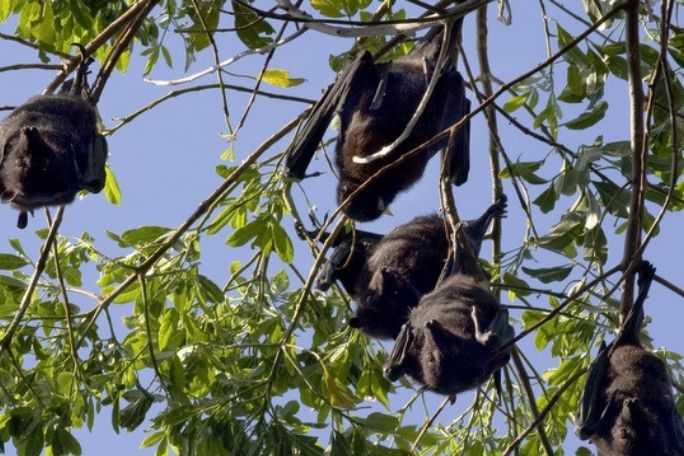Lesson summary
In this lesson, students consider how the behaviours of plants and animals can help us understand our changing environment. Students study two common flying-fox species to better understand the dynamic nature of ecosystems. Using a 2014 case study where an estimated 45,000 bats died during a heat wave, students will explore the environmental factors that led to this mass die-off, and how we can plan for these types of events in the future. To finish this lesson, students synthesise their learning by creating a short narrative for a Primary school audience about a bat species in their local area.
Learning intentions:
Students will...
- understand the interconnectedness of a key species to its environment
- know about the environmental significance of flying-foxes
- understand how environmental changes can have flow-on effects
- be able to use and understand primary and secondary sources
Success criteria:
Students can...
- conduct rigorous online research
- hypothesise about the possible impacts of an environmental change and justify their thinking
- participate in class discussions, drawing on knowledge they have gained in their research
Lesson guides and printables
Curriculum mapping
Australian curriculum content descriptions:
Year 9 Geography:
- Distribution and characteristics of biomes as regions with distinctive climates, soils, vegetation and productivity (ACHGK060).
- Human alteration of biomes to produce food, industrial materials and fibres, and the use of systems thinking to analyse the environmental effects of these alterations (ACHGK061).
- Develop geographically significant questions and plan an inquiry that identifies and applies appropriate geographical methodologies and concepts (ACHGS063).
Year 9 Science:
- Multi-cellular organisms rely on coordinated and interdependent internal systems to respond to changes to their environment (ACSSU175).
- Ecosystems consist of communities of interdependent organisms and abiotic components of the environment; matter and energy flow through these systems (ACSSU176).
Year 10 Geography:
- Select ONE of the following types of environment as the context for study: land (e.g. forests, deserts, grasslands, farmland), inland water, coast, marine or urban. A comparative study of examples selected from Australia and at least one other country should be included (ACHGK0082).
- The application of systems thinking to understanding the causes and likely consequences of the environmental change being investigated (ACHGK073).
- Environmental world views of people and their implications for environmental management (ACHGK071).
Year 10 Science:
- The theory of evolution by natural selection explains the diversity of living things and is supported by a range of scientific evidence (ACSSU185).
Syllabus outcomes: GE5-1, GE5-2, GE5-3, SC5-14LW.
General capabilities: Information and CommunicationTechnology (ICT) Capability, Critical and Creative Thinking.
Cross-curriculum priority: Sustainability OI.2.
Relevant parts of Year 9 Geography achievement standards: Students explain how geographical processes change the characteristics of places. They analyse interconnections between people, places and environments and explain how these interconnections influence people, and change places and environments. They predict changes in the characteristics of places over time and identify the possible implications of change for the future.
Relevant parts of Year 9 Science achievement standards: Students analyse how biological systems function and respond to external changes with reference to interdependencies, energy transfers and flows of matter.
Relevant parts of Year 10 Geography achievement standards: Students explain how interactions between geographical processes at different scales change the characteristics of places. Students identify, analyse and explain significant interconnections between people, places and environments and explain changes that result from these interconnections and their consequences.
Relevant parts of Year 10 Science achievement standards: Students explain the processes that underpin heredity and evolution.
Unit of work: ClimateWatch: Citizen Science – Geography – Years 9 & 10.
Time required: 100+ mins.
Level of teacher scaffolding: Medium – teachers will facilitate class discussions and a group research activity.
Resources required
- Student Worksheets (one copy per student)
- Data projector and connected internet-enabled device
- Enough internet-enabled devices to allow students to conduct paired research
- Lined paper for students to write a one-page story
- A range of coloured pencils or markers (optional)
Skills
- Collaboration
- Communication
- Critical thinking
- Digital literacy
Additional info
The lessons in this unit have been developed in partnership with Earthwatch.
Earthwatch developed the ClimateWatch program with the Bureau of Meteorology and The University of Melbourne to understand how changes in temperature and rainfall are affecting the seasonal behaviour of Australia’s plants and animals.


Welcome back!
Don't have an account yet?
Log in with:
By signing up to Cool.org you consent and agree to Cool's privacy policy to
store, manage and process your personal information. To read more, please see
our privacy policy here(Opens in new tab).
Create your free Cool.org account.
Many of our resources are free, with an option to upgrade to Cool+ for premium content.
Already have an account?
Sign up with:
By signing up to Cool.org you consent and agree to Cool's privacy policy to
store, manage and process your personal information. To read more, please see
our privacy policy here(Opens in new tab).